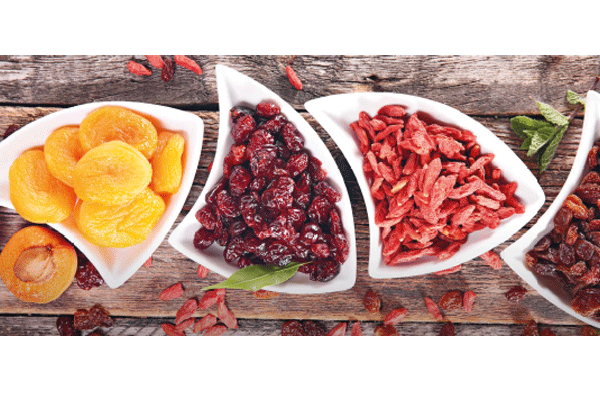IT’S TIME FOR THESE SAINTLY FOODS TO LOSE THEIR HEALTH HALO. BE SAVVY AND DROP THEM FROM YOUR DIET.



● DRIED FRUIT
After a bowl full of these tough bits, you’re nowhere near satisfied, but you would have had more sugar and calories than if you ate the fresh fruit.
Compare this: 100g of dried apple rings has about 250 calories and 53g of sugar, while 100g of fresh apple has about 85 calories and 10g of sugar.
Also, some of the fruit’s nutrients are lost in the dehydration process. While having some fruit is better than none, you can’t beat the benefits of fresh produce in this case.
● COCONUT
Marketed as a health food with antibacterial properties, the coconut’s proponents have been happily using it as cooking oil, adding it to vegan cheesecakes, pouring heaping spoonfuls into oatmeal, and using the cream in coffee.
However, with studies noting that coconut increases bad cholesterol and triglyceride (fat) levels, it isn’t a surprise that experts have refrained from endorsing the ingredient.
Besides, if you’re careful about avoiding butter, lard, and palm oil, can you really trust another fat that’s solid at room temperature?
● VEGAN CHEESECAKE
If you’ve ever tucked into one of these creamy slices and wondered how they could be so delicious and healthy, they’re not! Though you’d be hardpressed to find a health-food blog that doesn’t feature a recipe for it or sing its praises, these “raw power bars” are really calorie and fat bombs that should be reserved for treats.
Often made with nuts, stabilised with coconut oil, and sweetened with sugary dates or copious amounts of maple syrup (or honey if not vegan), each helping may be less processed than regular treats, but usually contains more than the
recommended serving of nuts (about a palmful), and delivers unnecessary sugar that you’re going to have to burn off.
● ENERGY BALLS
You knew we’d come after these, too, didn’t you? Sharing similar ingredients to vegan cheesecakes, these trufflesized balls tend to also contain chopped pieces of dried fruit, seeds, and even chocolate chips.
Small though they may be, each piece has about 100 calories (and that’s being conservative), and while they may have more nutrients and fibre than a candy bar, caloriewise, you’re not getting away with anything.
● GLUTEN-FREE PRODUCTS
According to the Celiac Disease Foundation in the US, only an estimated one per cent of the world’s population has coeliac disease, which causes gluten hypersensitivity in the small intestine, and leads to difficulty in digesting food. Yet people have somehow gotten the idea that gluten is bad.
Gluten-free products are neither any healthier nor lower in fat, calories or carbs than regular foods. Plus, it’s a real drag to avoid its sources, which include grains like wheat, barley, rye, spelt, farro, and oats. This means you’d have to watch for pastas, baked goods, gravies, soups, salad dressings, and even soya sauce!
Experts are warning against hopping on the gluten-free bandwagon as it could mean missing out on valuable essential nutrients and fibre due to a limited diet.
A report in Epidemiology also shared that you could be exposing yourself to more mercury and arsenic, commonly found in farming chemicals used to grow rice, a popular ingredient in gluten-free products. Consider this before chewing on another bland, airpopped rice snack.























